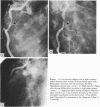Abstract
Early experience with percutaneous transluminal coronary angioplasty (from October 1979 to March 1983 inclusive) showed that pre-existing coronary artery thrombus was associated with a significant increase in the incidence of acute coronary occlusion during angioplasty. Acute occlusion occurred in 11 (73%) of 15 patients with pre-existing thrombus compared with 18 (8%) of 223 patients without thrombus. The effect of improved technology (steerable guiding systems) and altered dilatation strategy (full intravenous heparinisation for 24 hours after the procedure and more intensive use of antiplatelet medications) was studied by review of angiograms from 297 consecutive patients without evidence of acute myocardial infarction who underwent angioplasty from April 1983 to March 1985 inclusive. Coronary artery thrombus was present in 34 (11%) patients, eight (24%) of whom had complete occlusion during or immediately after the procedure compared with 34 (13%) of 263 patients without thrombus. Patients with pre-existing coronary artery thrombus continue to be at greater risk of complete occlusion than patients without thrombus, but this risk has declined significantly since the modification of the angioplasty procedure.
Full text
PDF




Images in this article
Selected References
These references are in PubMed. This may not be the complete list of references from this article.
- Ambrose J. A., Winters S. L., Stern A., Eng A., Teichholz L. E., Gorlin R., Fuster V. Angiographic morphology and the pathogenesis of unstable angina pectoris. J Am Coll Cardiol. 1985 Mar;5(3):609–616. doi: 10.1016/s0735-1097(85)80384-3. [DOI] [PubMed] [Google Scholar]
- Bresnahan D. R., Davis J. L., Holmes D. R., Jr, Smith H. C. Angiographic occurrence and clinical correlates of intraluminal coronary artery thrombus: role of unstable angina. J Am Coll Cardiol. 1985 Aug;6(2):285–289. doi: 10.1016/s0735-1097(85)80161-3. [DOI] [PubMed] [Google Scholar]
- Cairns J. A., Gent M., Singer J., Finnie K. J., Froggatt G. M., Holder D. A., Jablonsky G., Kostuk W. J., Melendez L. J., Myers M. G. Aspirin, sulfinpyrazone, or both in unstable angina. Results of a Canadian multicenter trial. N Engl J Med. 1985 Nov 28;313(22):1369–1375. doi: 10.1056/NEJM198511283132201. [DOI] [PubMed] [Google Scholar]
- DeWood M. A., Spores J., Notske R., Mouser L. T., Burroughs R., Golden M. S., Lang H. T. Prevalence of total coronary occlusion during the early hours of transmural myocardial infarction. N Engl J Med. 1980 Oct 16;303(16):897–902. doi: 10.1056/NEJM198010163031601. [DOI] [PubMed] [Google Scholar]
- Dorros G., Cowley M. J., Simpson J., Bentivoglio L. G., Block P. C., Bourassa M., Detre K., Gosselin A. J., Grüntzig A. R., Kelsey S. F. Percutaneous transluminal coronary angioplasty: report of complications from the National Heart, Lung, and Blood Institute PTCA Registry. Circulation. 1983 Apr;67(4):723–730. doi: 10.1161/01.cir.67.4.723. [DOI] [PubMed] [Google Scholar]
- Holmes D. R., Jr, Hartzler G. O., Smith H. C., Fuster V. Coronary artery thrombosis in patients with unstable angina. Br Heart J. 1981 Apr;45(4):411–416. doi: 10.1136/hrt.45.4.411. [DOI] [PMC free article] [PubMed] [Google Scholar]
- Kent K. M., Bentivoglio L. G., Block P. C., Cowley M. J., Dorros G., Gosselin A. J., Gruntzig A., Myler R. K., Simpson J., Stertzer S. H. Percutaneous transluminal coronary angioplasty: report from the Registry of the National Heart, Lung, and Blood Institute. Am J Cardiol. 1982 Jun;49(8):2011–2020. doi: 10.1016/0002-9149(82)90223-5. [DOI] [PubMed] [Google Scholar]
- Lewis H. D., Jr, Davis J. W., Archibald D. G., Steinke W. E., Smitherman T. C., Doherty J. E., 3rd, Schnaper H. W., LeWinter M. M., Linares E., Pouget J. M. Protective effects of aspirin against acute myocardial infarction and death in men with unstable angina. Results of a Veterans Administration Cooperative Study. N Engl J Med. 1983 Aug 18;309(7):396–403. doi: 10.1056/NEJM198308183090703. [DOI] [PubMed] [Google Scholar]
- Mabin T. A., Holmes D. R., Jr, Smith H. C., Vlietstra R. E., Bove A. A., Reeder G. S., Chesebro J. H., Bresnahan J. F., Orszulak T. A. Intracoronary thrombus: role in coronary occlusion complicating percutaneous transluminal coronary angioplasty. J Am Coll Cardiol. 1985 Feb;5(2 Pt 1):198–202. doi: 10.1016/s0735-1097(85)80037-1. [DOI] [PubMed] [Google Scholar]
- Mandelkorn J. B., Wolf N. M., Singh S., Shechter J. A., Kersh R. I., Rodgers D. M., Workman M. B., Bentivoglio L. G., LaPorte S. M., Meister S. G. Intracoronary thrombus in nontransmural myocardial infarction and in unstable angina pectoris. Am J Cardiol. 1983 Jul;52(1):1–6. doi: 10.1016/0002-9149(83)90059-0. [DOI] [PubMed] [Google Scholar]
- May G. S., Furberg C. D., Eberlein K. A., Geraci B. J. Secondary prevention after myocardial infarction: a review of short-term acute phase trials. Prog Cardiovasc Dis. 1983 Jan-Feb;25(4):335–359. doi: 10.1016/0033-0620(83)90013-0. [DOI] [PubMed] [Google Scholar]
- Vlietstra R. E., Holmes D. R., Jr, Smith H. C., Hartzler G. O., Orszulak T. A. Percutaneous transluminal coronary angioplasty: initial Mayo Clinic experience. Mayo Clin Proc. 1981 May;56(5):287–293. [PubMed] [Google Scholar]



